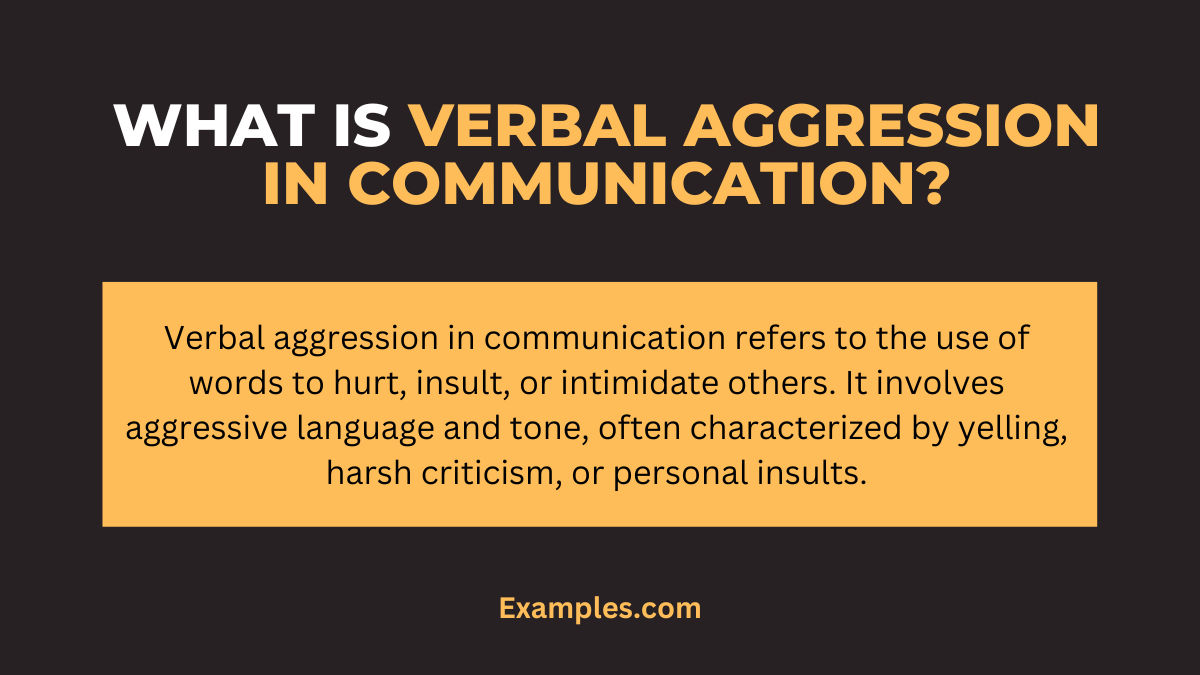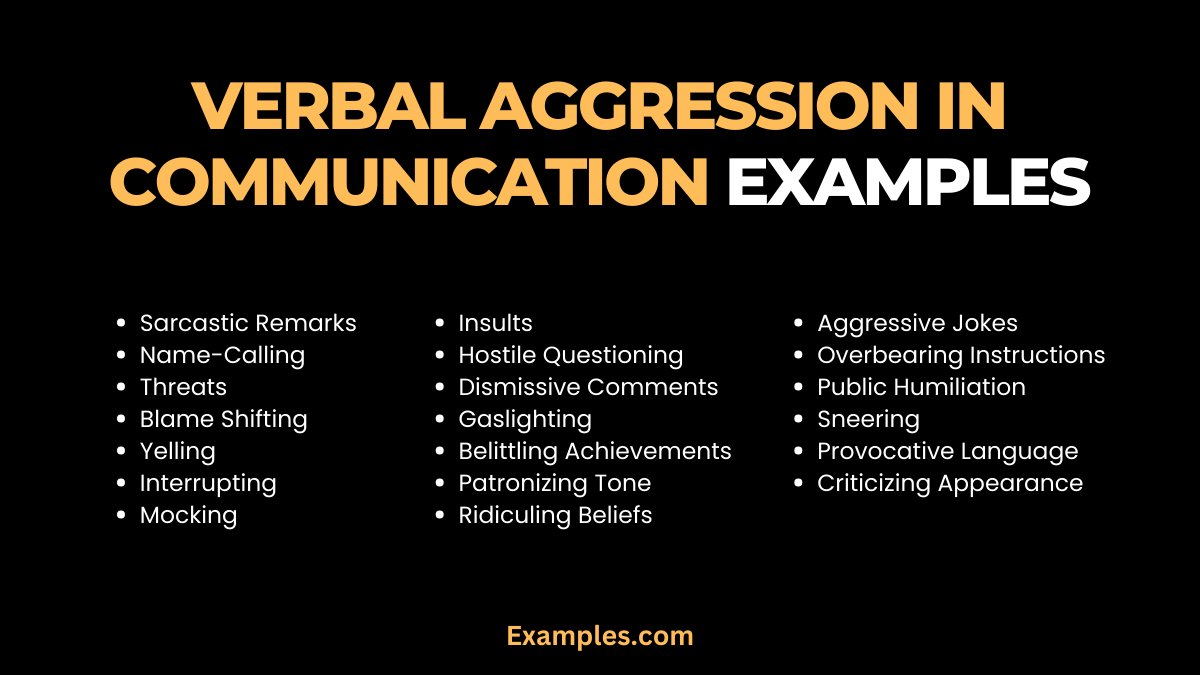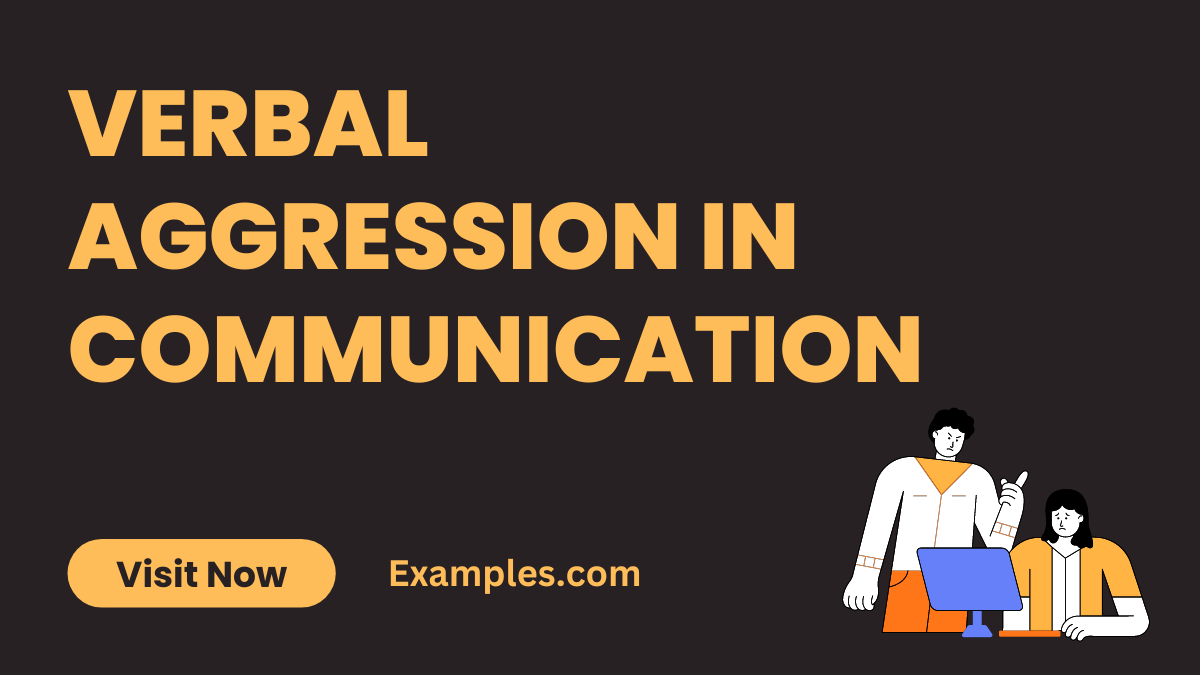19+ Verbal Aggression in Communication Examples
What is Verbal Aggression in Communication?

Verbal aggression in communication refers to the use of words to hurt, insult, or intimidate others. It involves aggressive language and tone, often characterized by yelling, harsh criticism, or personal insults. This type of communication can occur in various settings, including personal relationships, workplaces, and public interactions. Verbal aggression undermines respectful dialogue and can lead to strained relationships and hostile environments. Understanding and addressing this communication style is crucial for maintaining healthy and constructive interactions.
20 Verbal Aggression in Communication Examples

Verbal aggression in communication is characterized by the use of words to hurt, insult, or degrade another person. This form of communication can be particularly damaging as it directly targets an individual’s self-esteem and can escalate conflicts. Understanding examples of verbal aggression is crucial for recognizing and addressing it effectively. This guide provides 20 distinct examples, each accompanied by an explanation and a sample sentence. These examples illustrate various aggressive verbal behaviors, helping individuals identify such communication and develop strategies to counteract or de-escalate aggressive situations, thereby fostering a more respectful and constructive dialogue.
- Sarcastic Remarks: Using sarcasm to belittle someone. Example: “Oh, brilliant idea! Like you could ever come up with something useful.”
- Name-Calling: Insulting or demeaning labels. Example: “You’re such an idiot, you never understand anything right.”
- Threats: Using threatening language to intimidate. Example: “If you don’t do this, you’ll regret it.”
- Blame Shifting: Assigning fault unfairly. Example: “It’s all your fault that we’re in this mess.”
- Yelling: Raising voice excessively. Example: “I can’t believe you did that!” shouted at a high volume.
- Interrupting: Constantly cutting off while speaking. Example: “Stop talking, what you’re saying is pointless.”
- Mocking: Mimicking in a derogatory manner. Example: “Oh, ‘I’m too scared.’ Grow up!”
- Insults: Derogatory comments about personal traits. Example: “You’re too stupid to understand simple things.”
- Hostile Questioning: Aggressively interrogating. Example: “Why do you always mess up? What’s wrong with you?”
- Dismissive Comments: Showing blatant disrespect. Example: “Whatever you think doesn’t matter anyway.”
- Gaslighting: Manipulating someone into questioning their sanity. Example: “You’re crazy, that never happened.”
- Belittling Achievements: Minimizing someone’s success. Example: “Your contribution was minimal, anyone could have done it.”
- Patronizing Tone: Talking down to someone. Example: “Let me explain this since you can’t understand it yourself.”
- Ridiculing Beliefs: Making fun of someone’s values. Example: “Your beliefs are ridiculous and make no sense.”
- Aggressive Jokes: Humor at someone’s expense. Example: “It’s just a joke, can’t you take a joke?”
- Overbearing Instructions: Commanding in a demeaning way. Example: “Do it my way, your method is useless.”
- Public Humiliation: Embarrassing someone in front of others. Example: “Look everyone, see how clueless they are.”
- Sneering: Expressing contempt through facial expressions. Example: Sneering while someone is talking.
- Provocative Language: Using words to incite anger. Example: “You’re just a coward, aren’t you?”
- Criticizing Appearance: Negative comments about someone’s looks. Example: “With that outfit, you look like a clown.”
Verbal Aggression in Communication Examples in Psychology
Verbal aggression in psychology is often examined for its impact on interpersonal relationships and mental health. This includes understanding aggressive communication patterns and their psychological underpinnings. Examples in this field focus on the triggers, emotional responses, and long-term effects of such aggressive behavior.
- “You always mess things up!” – An accusation that generalizes and attacks the person’s character.
- “Why can’t you ever do anything right?” – A rhetorical question that implies incompetence.
- “You’re just like your father, useless!” – A personal insult that also brings in family dynamics.
- “Nobody cares about your stupid ideas!” – Dismissive language that devalues the other person’s contributions.
- “Shut up! I know what I’m talking about!” – A dismissive command that undermines the other person’s opinion or knowledge.
Verbal Aggression in Communication Examples in the Workplace
In the workplace, verbal aggression can significantly impact team dynamics, employee morale, and overall productivity. Examples in this context highlight the damaging effects of aggressive communication on professional relationships and workplace culture.
- “That was a stupid mistake. What were you thinking?” – Criticizing an employee harshly instead of offering constructive feedback.
- “If you can’t handle this, maybe you shouldn’t be here.” – Intimidating language that questions the employee’s competence.
- “I don’t care what you think, just do what I say!” – Authoritative and dismissive statement that disregards employee input.
- “This is the worst presentation I’ve ever seen!” – Demeaning feedback that lacks professionalism.
- “You’re lucky to even have this job.” – A statement that belittles the employee’s contribution and instills fear.
What are the Causes of Verbal Aggression in Communication?
Verbal aggression in communication often stems from a variety of underlying causes. These include:
- Emotional Triggers: Intense emotions like anger, frustration, or fear can lead to aggressive communication. These emotions often override rational thinking and lead to impulsive verbal outbursts.
- Learned Behavior: In some cases, verbal aggression is a learned behavior, modeled after family members, peers, or influential figures who regularly use aggressive communication.
- Stress and Pressure: High levels of stress or pressure, whether in personal life or at work, can result in a lower threshold for patience and increase the likelihood of aggressive responses.
- Lack of Communication Skills: Individuals may resort to aggression in communication due to a lack of effective communication skills, such as the inability to express themselves assertively yet respectfully.
- Cultural and Social Influences: In some cultures or social groups, verbal aggression may be seen as a norm or an acceptable way of expressing oneself.
- Mental Health Issues: Certain mental health conditions can contribute to aggressive communication styles, particularly if they impact impulse control or emotional regulation.
- Feeling Threatened: A perceived threat to one’s self-esteem, status, or beliefs can trigger a defensive, aggressive response.
Understanding these causes is crucial in addressing and mitigating verbal aggression in various contexts.
How to Deal with Verbal Aggression in Communication?
Dealing with verbal aggression in communication effectively involves several strategies:
- Stay Calm and Composed: Keeping calm under pressure is key. It prevents further escalation and helps maintain control of the situation.
- Do Not Retaliate with Aggression: Responding aggressively only fuels the situation. Instead, remain calm and assertive.
- Empathize, But Don’t Enable: Understanding the aggressor’s perspective is important, but it’s crucial not to condone aggressive behavior.
- Seek to De-escalate: Employing tactics like changing the subject or suggesting a break can help calm the situation.
- Address the Behavior, Not the Person: Focus on discussing the behavior’s impact rather than labeling or attacking the individual.
- Consider the Context: Tailor your response based on your relationship with the aggressor and the situation at hand.
- Professional Help for Chronic Aggression: In cases of repeated aggression, it may be beneficial for the aggressor to seek professional help to address underlying issues.
Adopting these strategies can help manage aggressive situations and foster a more respectful communication environment.
Tips for Managing Verbal Aggression in Communication
Managing verbal aggression in communication effectively requires a strategic approach that can help in de-escalating tense situations and fostering a more constructive dialogue:
- Recognize Aggressive Signs: Be aware of the signs of verbal aggression, such as raised voices, harsh language, or personal insults.
- Stay Calm: Maintain your composure. Responding to aggression with aggression often exacerbates the situation.
- Listen Actively: Show that you are listening and trying to understand their perspective, even if you don’t agree.
- Use Empathetic Language: Respond with empathy. Acknowledge their feelings without necessarily agreeing with their stance.
- Avoid Retaliation: Resist the urge to retaliate with similar aggression, as this can spiral into a more intense conflict.
- Seek Clarification: Ask for clarifications on specific points. This can sometimes reveal misunderstandings at the heart of the aggression.
- Focus on De-Escalation: Use calming language and suggest taking a break if the conversation becomes too heated.
- Offer Constructive Feedback: If appropriate, provide feedback about how their aggression impacts communication and relationships.
Implementing these strategies can help manage verbal aggression more effectively, leading to healthier and more productive interactions.
In conclusion, managing verbal aggression in communication is essential for maintaining healthy interpersonal relationships and a positive work environment. Recognizing and addressing aggressive behaviors constructively can prevent misunderstandings and conflicts. It’s crucial to foster a culture of respectful and empathetic dialogue, where all parties feel heard and valued. Effectively handling verbal aggression leads to more effective communication and stronger, more cooperative relationships.



